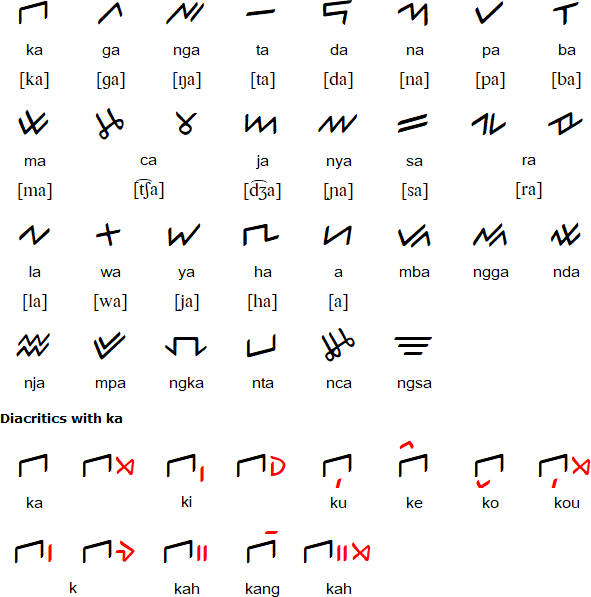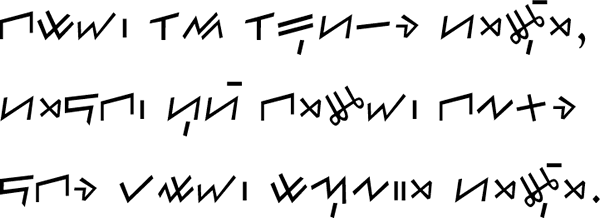The Incung script developed during the 14th century and is used to write the Kerinci language, a Malayic language spoken mainly in the Kerinci Regency of Jambi Province of Sumatra in Indonesia. It is thought to have descended from the Old Sumatran script.
The Incung script is also known as surat incung in Indonesian or surat incung in Kerinci. The word incoung means "slanted". The script is used mainly for decorative purposes on road signs, government office signs and on tourist trinkets. Kerinci is usually written with the Latin alphabet
Traditionally the Incung scirpt was written on bamboo, buffalo horn, bark or paper using a sharpened bamboo pen or quill. It was used to record traditional knowledge, historical events and religious texts. Efforts are being made to preserve and promote the use of the script.

Download an alphabet chart for Incung (Excel)

Kamai bangga basuhat incoung, idak uhang kincai kalau dak pandai manulih incoung.
We are proud using the Incoung script, don't claim to be a native Kerinci person if you can't write with the Incoung script.
Some information provided by Ridwan Maulana. If you have any questions about this script, you can contact Ridwan at ridwanmaul768@gmail.com
Information about the Incung script
https://fr.wikipedia.org/wiki/Kerinci_(langue)
https://id.wikipedia.org/wiki/Aksara_Incung
https://indonesianfolklore.blogspot.com/p/script.html
https://eap.bl.uk/archive-file/EAP117-29-1-1
Incung fonts
https://aksaradinusantara.com/fonta/aksara/incung
Ahom, Aima, Arleng, Badagu, Badlit, Basahan, Balinese, Balti-A, Balti-B, Batak, Baybayin, Bengali, Bhaiksuki, Bhujimol, Bilang-bilang, Bima, Blackfoot, Brahmi, Buhid, Burmese, Carrier, Chakma, Cham, Cree, Dehong Dai, Devanagari, Dham Lipi, Dhankari / Sirmauri, Ditema, Dives Akuru, Dogra, Ethiopic, Evēla Akuru, Fox, Fraser, Gond, Goykanadi, Grantha, Gujarati, Gunjala Gondi, Gupta, Gurmukhi, Halbi Lipi, Hanifi, Hanuno'o, Hočąk, Ibalnan, Incung, Inuktitut, Jaunsari Takri, Javanese, Kaithi, Kadamba, Kamarupi, Kannada, Kawi, Kharosthi, Khema, Khe Prih, Khmer, Khojki, Khudabadi, Kirat Rai, Kōchi, Kodava Lipi, Komering, Kulitan, Kurukh Banna, Lai Tay (Tai Yo), Lampung, Lanna, Lao, Leke, Lepcha, Limbu, Lontara/Makasar, Lota Ende, Magar Akkha, Mahajani, Malayalam, Meitei (Modern), Manpuri (Old), Marchen, Meetei Yelhou Mayek, Meroïtic, Masarm Gondi, Modi, Mon, Mongolian Horizontal Square Script, Multani, Nandinagari, Newa, New Tai Lue, Ojibwe, Odia, Ogan, Pahawh Hmong, Pallava, Phags-pa, Purva Licchavi, Qiang / Rma, Ranjana, Rejang (Kaganga), Sasak, Savara, Satera Jontal, Shan, Sharda, Sheek Bakrii Saphaloo, Siddham, Sinhala, Sorang Sompeng, Sourashtra, Soyombo, Sukhothai, Sundanese, Syloti Nagri, Tagbanwa, Tai Noi, Takri, Tamil, Tanchangya (Ka-Pat), Tani, Thaana, Telugu, Thai, Thirke, Tibetan, Tigalari, Tikamuli, Tocharian, Tolong Siki, Vatteluttu, Warang Citi
Page created: 12.06.23. Last modified: 26.09.23
[top]
You can support this site by Buying Me A Coffee, and if you like what you see on this page, you can use the buttons below to share it with people you know.

If you like this site and find it useful, you can support it by making a donation via PayPal or Patreon, or by contributing in other ways. Omniglot is how I make my living.
Note: all links on this site to Amazon.com, Amazon.co.uk
and Amazon.fr
are affiliate links. This means I earn a commission if you click on any of them and buy something. So by clicking on these links you can help to support this site.
[top]